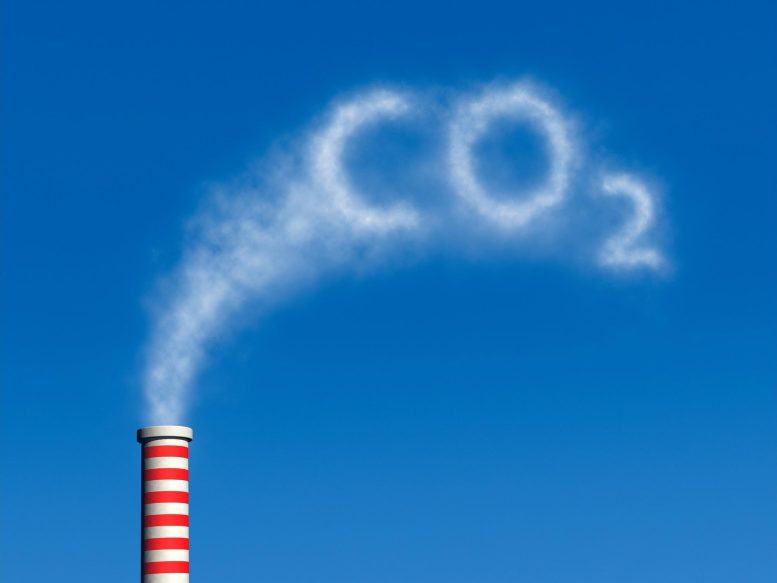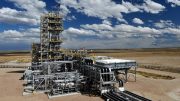
Power plants that generate electricity through the combustion of fossil fuels are a significant contributing factor to the increase in atmospheric carbon dioxide.
Over the last couple of hundred years, the amount of carbon dioxide in our atmosphere has skyrocketed. Scientists predict that if we don’t remove at least some of it, there will be even more heat waves, wildfires, hurricanes, and other climate disasters. In this episode of the American Chemical Society’s video series Reactions, they break down how people are using chemistry to make that happen.
Video Transcript:
What if I told you that chemists are working on something right now, that could be as big of an industry as the internet, and just as profitable in 50 years?
Elon Musk is offering $100 million, the largest incentive prize ever, to whoever can come up with a successful carbon removal method. And a hundred million bucks is nothing compared to what this industry is going to be in 50 years.
XPRIZE Carbon Removal is aimed at tackling the biggest threat facing humanity — fighting climate change and rebalancing Earth’s carbon cycle. Funded by Elon Musk and the Musk Foundation, this $100M competition is the largest incentive prize in history, an extraordinary milestone.?
Why? Because it has to work. Every climate projection relies on us pulling out some of the CO2 in our atmosphere to avoid…
So Elon, here’s my plan. Trees. Let’s just plant a bunch of trees. Honestly, why has no one thought of this before?
Okay, Let’s math this. Say we want to get back to a time before the industrial revolution, in the mid 17 hundreds, when our atmosphere’s CO2 concentration was much, much lower.
[MATH]
That’s 1.2 trillion tons of CO2 to get rid of.
[MATH]
So we would need 60 trillion trees just to get back to pre-industrial revolution carbon dioxide levels. That’s a lot of planting. Plus it takes a while for trees to grow, not to mention that the escalation in wildfires that we’re seeing means more trees are burning more often. And when they burn, they release CO2.
So, uh, we might need something more efficient than trees.
What if I go right to the source, to places that are emitting a lot of CO2, like power plants?
Okay. People already thought of that. It’s called carbon capture and storage or CCS. No, no, no, no, no, no. C C S.
We do have CCS facilities throughout the world, including in the U S. The most popular method for collecting CO2 from exhaust is amine scrubbing. So you run exhaust through a column, filled with an alkaline amine solution compounds in that solution will bind to the CO2, pulling it out of the exhaust so that it can’t escape into the atmosphere.
Next, you have to release the CO2 from the amine solution so that you can store it, which means heating the solution up to break those bonds, and then compressing the released CO2.
This of course takes energy, which means burning fossil fuels and releasing CO2. So it’s not perfect, but it’s still preventing as much CO2 from getting into our atmosphere.
Existing CCS facilities capture and store tens of millions of tons of CO2 each year, but we’re still emitting around 40 billion tons of CO2 each year. So we need a lot more of these CCS facilities to help reduce our emissions, but we also need to pull out CO2 that’s already in the atmosphere.
No matter how good CCS gets, it won’t help with the CO2 that’s already up there. That’s where carbon dioxide removal comes in.
Carbon dioxide removal or CDR means pulling CO2 out of the atmosphere. It’s often confused with carbon capture and storage or CCS, but they’re not the same thing.
CCS is about preventing the release of carbon dioxide from a specific source like emissions coming out of a smokestack. CDR is about filtering the entire atmosphere of our planet. It’s a lot harder, and that’s why our buddy Elon is offering $100 million to whoever can solve that puzzle.
Why is it so hard? Well, CO2 is a very small percentage of the molecules you’ll find in our atmosphere. So let’s say you have a gigantic fan that can suck in 10,000 tons of air per minute, of those 10,000 tons, only six are CO2.
You need to wade through 10,000 tons of air just to pull out six.
So if you wanted to pull 1.2 trillion tons of CO2 out of the atmosphere to get back to those pre-industrial revolution levels, you’d have to wade through around two quadrillion tons of atmosphere.
That’s nearly half of our entire atmosphere. And that’s assuming that your carbon capture method is 100% efficient.
Also, Earth has a natural carbon cycle where oceans and land are releasing CO2 all the time. So if we somehow managed to remove 1.2 trillion tons of CO2 from the atmosphere overnight, that shift in atmospheric CO2 levels would actually pull a lot of carbon dioxide out of the oceans and land to maintain equilibrium.
So what are people who are trying to win this hundred million dollar prize doing?
I called some people up to see. Can you give me more details about how that works? No, no, no, no, no, no. I’m not going to steal it. I’m just going to put it on YouTube. Hello?
Although I don’t know exactly what people are doing to win that prize money, there are some technologies and proposed ways of pulling carbon dioxide from the atmosphere that exist already, like restoring and maintaining blue carbon, coastal marine ecosystems, like mangrove and tidal marshes and seagrasses that pull a lot of CO2 from the atmosphere, or deploying a bunch of kelp out into our oceans that will absorb CO2 at the surface and then fall to the ocean floor, taking the CO2 with them.
There’s a company I came across that’s using fans to draw air into a collector where the CO2 is collected on a filter, made out of amines supported by cellulose fibers.
So there are a lot of ways to collect carbon dioxide, but then what do you do with it? Where do you store it?
Capturing carbon isn’t simple, but storing it is much harder. Injecting carbon dioxide underground is a pretty popular approach, but that’s sometimes used to extract more oil and gas, which ultimately means releasing CO2 into the atmosphere.
There are also some public safety concerns about leakage and even seismic activity.
Another option is to dig into rocky formations that are deep in the ocean and pump compressed CO2 down there, where it’ll dissolve into the saltwater and get trapped in the minerals and rocks.
Successfully storing CO2 deep in the ocean or underground isn’t just about where you put it, it’s about how you keep it there. You have to prevent the CO2 from just leaking right back out, and you have to trap it there for centuries.
There’s actually a new proposal to create a device that could convert the CO2 in seawater to carbonate minerals like calcite, and then filter them out and concentrate them into larger solids.
The really exciting thing about this proposal is that it’s actually doing both carbon dioxide removal and storage in a single process, and has a relatively low energy cost.
We could do an entire video about the chemistry behind this idea, but for now, if you’re interested in learning more, we’re putting a link to the paper in the description of this video.
And of course, this is just a proposal. No, one’s actually built one of these devices yet. So maybe I’ll get cracking on that for my shot at that sweet, sweet CDR money.
No, no, no, no,
Stop it. Stop it.









“…, the amount of carbon dioxide in our atmosphere has skyrocketed.”
It hasn’t even doubled in 200 years.
“So if we somehow managed to remove 1.2 trillion tons of CO2 from the atmosphere overnight, that shift in atmospheric CO2 levels would actually pull a lot of carbon dioxide out of the oceans and land to maintain equilibrium.”
That may explain why when, in 2020, the rate of anthropogenic emissions declined, there was no measurable impact on atmospheric CO2 concentrations or average global temperatures.
https://wattsupwiththat.com/2021/06/11/contribution-of-anthropogenic-co2-emissions-to-changes-in-atmospheric-concentrations/
https://wattsupwiththat.com/2022/03/22/anthropogenic-co2-and-the-expected-results-from-eliminating-it/
If we were truly concerned about climate change we would recognize next generation nuclear power as the only serious way to price fossil fuel out of existence. The molten salt reactors look to be safer and operate at higher temperature (thermal efficiency). Let plants do the rest – the decay rate of extra CO2 above equilibrium is about 52 years (e-fold time) or 40 years (half-life time).